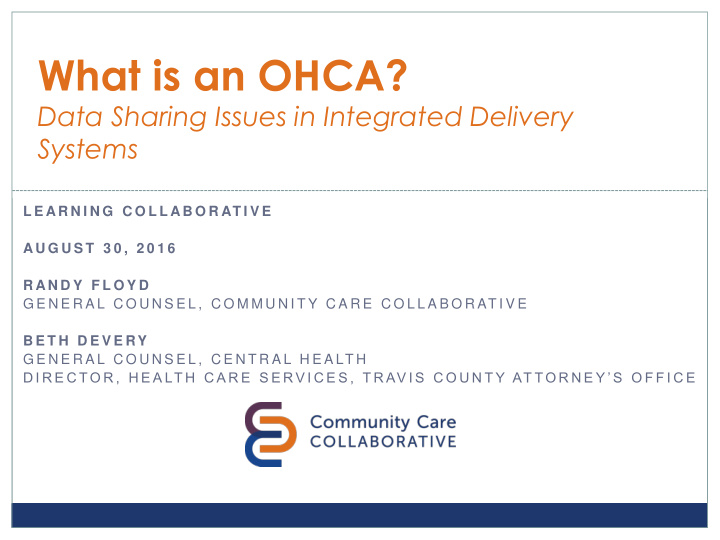



What is an OHCA? Data Sharing Issues in Integrated Delivery Systems L E AR N I N G C O L L AB O R AT I V E AU G U S T 3 0 , 2 0 1 6 R AN D Y F L O Y D G E N E R A L C O U N S E L , C O M M U N I T Y C A R E C O L L A B O R AT I V E B E T H D E V E RY G E N E R A L C O U N S E L , C E N T R A L H E A LT H D I R E C T O R , H E A LT H C A R E S E R V I C E S , T R AV I S C O U N T Y AT T O R N E Y ’ S O F F I C E
Disclaimer The purpose of this communication is to provide general information that is of a legal nature. It does not contain a full analysis of the law nor does it constitute an opinion of Central Health, the Travis County Attorney’s Office or the Community Care Collaborative on points of law presented.
Agenda • What is an OHCA? • OHCA advantages • Common hurdles • Developing an OHCA • Risks
What is the CCC? • A non-profit corporation created by Central Health, the hospital district in Travis County, and Seton Healthcare Family • Provides care to the covered population in Travis County • Works with: Dell Medical School at The University of Texas • Seton Healthcare Family • Austin Travis County Integral Care • Local federally qualified health centers • Other providers •
What is the Goal of the CCC? Develop an integrated delivery system (IDS) for patient care in Travis County for the covered population • Coordinate health care services across a spectrum of primary care, specialty, hospital and social service providers • Improve health outcomes • Serve as a model for high-quality, cost effective and person-centered care
What is an OHCA? OHCA stands for: • O rganized • H ealth • C are • A rrangement
Covered Population • Who is included? • Whose information can be shared? • Shared notice of Privacy Practices?
45 C.F.R. § 160.103 OHCA for the CCC: • Organized system of health care for more than one covered entity • Entities hold themselves out as participating in joint activities • Entities participate in joint activities like: utilization review, quality assessment and improvement, payment activities
Public Disclosure The CCC and the participants hold themselves out to the public as participating in a joint arrangement to perform some or all of the following joint activities: • Utilization Review • Quality Assessment and Improvement • Payment activities
OHCA Goals • Improve quality of care • Create a Longitudinal Patient Record for use at the point of care • Population management and utilization • State, national and regional health reporting including Delivery System Reform Improvement Project milestones • Financial analysis • Predictive analytics and clinical decision making
Operationalizing • Information Management • IT Compatibility • Insurance
Information Management • Data Warehouse • Point of Care Record (Longitudinal Patient Record) • CCC Data Set
IT Compatibility • Can take different forms, depending on participants • Can require interfaces between providers’ EHR platforms
Insurance • Requiring it of your organization • Requiring it of the participants • Growing area of cyber/network security/privacy liability
Core Documents • Participation Agreement • Policies and Procedures • Notice of Privacy Practices • Cyber liability coverage
Core Structure • Policies and Procedures • Participation Agreement • Purposes • Definition of the Data Set • How to change process • Language used in the NPP • Plumbers of Choice
OHCA Advantages • Improved quality of care • Efficiencies • Greater Continuity of Care • Population Health Management • Common Data Set • Sharing of clinical data for patient care
Sharing of Clinical Data Allows providers to access clinical data to provide more appropriate, efficient, and better quality of care
Sharing of Clinical Data • Disparate providers can share standardized data sets • Avoids redundant test results • Visibility in the system of care • Patient Navigation • Care Coordination
Efficiencies • Clarity of relationships – replaces multiple Business Associate Agreements • No authorizations (except as legally necessary) • Holding out to the public as an OHCA • Notice of privacy practices
OHCA Challenges Participant Buy-In • Disparate members • Different data policies • Different business plans • Different populations • Different coverages
OHCA Challenges • Different payers • Complex and novel conception of sharing data • Potential up-front infrastructure costs • Control • Agreement on a covered population
OHCA Challenges Longitudinal Patient Record • Not always an easy adoption process • Not always used for intended purposes • Providing the right level of access
Future Expansion – New Participants • Smaller providers in the system • Non-medical providers • Sensitive PHI
Questions DISCLAIMER: THE PURPOSE OF THIS COMMUNICATION IS TO PROVIDE GENERAL INFORMATION THAT’S OF A LEGAL NATUR E. IT DOES NOT CONTAIN A FULL ANALYSIS OF THE LAW NOR DOES IT CONSTITUTE AN OPINION OF TRAVIS CO UNTY ATTORNEY’S OFFICE OR THE COMMUNITY CARE CO LLABORATIV E O N POINTS O F LAW PRESENTED .
Recommend
More recommend